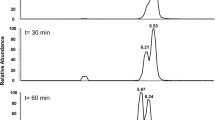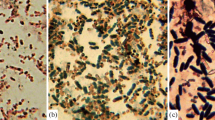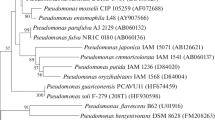Abstract
A degradation pathway for dl-α-phenylhydracrylic, phenylacetic, 3- and 4-hydroxyphenylacetic acid by a Flavobacterium is presented. Experiments with washed cells and enzyme studies revealed that dl-α-phenylhydracrylic acid in an initial reaction was oxidatively decarboxylated to phenylacetaldehyde. Whole cells oxidized both stereoisomers of phenylhydracrylic acid at different rates. The product phenylacetaldehyde in turn was oxidized to phenylacetic acid. No hydroxylation of phenylacetic acid was detected in cell extracts, but on the basis of experiments with washed cells it is assumed that phenylacetic acid is mainly metabolized via 3-hydroxyphenylacetic acid. This latter product was subsequently hydroxylated yielding the ring-cleavage substrate homogentisate. 4-Hydroxyphenylacetic acid was also degraded via homogentisate. Ringcleavage of homogentisate gave maleylacetoacetate which was further degraded through a glutathione-dependent pathway. Homoprotocatechuate was not an intermediate in the metabolism of dl-phenylhydracrylic acid, phenylacetic, 3- and 4-hydroxyphenylacetic acid metabolism, but it could be hydroxylated aspecifically to 2,4,5-trihydroxyphenylacetic acid by the action of the 3-hydroxyphenylacetic acid-6-hydroxylase.
Similar content being viewed by others
Abbreviations
- HPLC:
-
high-performance liquid chromatography
- PHA:
-
phenylhydracrylic acid
- PA:
-
phenylacetic acid
- HPA:
-
hyxdroxyphenylacetic acid
- PMS:
-
phenazine methosulphate
- PMA:
-
phenylmalonic acid
- GSH:
-
glutathione
References
Baggi G, Boga MM, Catelani D, Galli E, Treccani V (1983) Styrene catabolism by a strain of Pseudomonas fluorescens. System Appl Microbiol 4:141–147
Blakley ER, Kurz W, Halvorson H, Simpson FJ (1967) The metabolism of phenylacetic acid by a Pseudomonas. Can J Microbiol 13:147–157
Bouchara E (1971) Analgesic and antiinflammatory substituted phenylacetic acids. French Patent no 2054532
Cooper RA, Skinner MA (1980) Catabolism of 3- and 4-hydroxyphenylacetate by the 3,4-dihydroxyphenylacetate pathway in Escherichia coli. J Bacteriol 143:302–306
Crawford RL (1976) Degradation of homogentisate by strains of Bacillus and Moraxella. Can J Microbiol 22:276–280
Crawford RL, Frick TD (1977) Rapid spectrophotometric differentiation between glutathione-dependent and glutathione-independent gentisate and homogentisate pathways. Appl Environ Microbiol 34:170–174
Fujioka M, Morino Y, Wada H (1970) Metabolism of phenylalanine (Achromobacter eurydice). In: Tabor H, White-Tabor C (eds) Methods in enzymology, vol 17. Academic Press, New York, pp 585–596
Hagedorn SR, Chapman PJ (1985) Glutathione-independent maleylacetoacetate isomerase in Gram-positive bacteria. J Bacteriol 163:803–805
Hagedorn SR, Bradly G, Chapman PJ (1985) Glutathione-independent isomerization of maleylpyruvate by Bacillus megaterium and other Gram-positive bacteria. J Bacteriol 163:640–647
Hareland WA, Crawford RL, Chapman PJ, Dagley S (1975) Metabolic function and properties of 4-hydroxyphenylacetic acid 1-hydroxylase from Pseudomonas acidovorans. J Bacteriol 121:272–285
Holmes B, Owen RJ, McMeekin TA (1984) Flavobacterium. In: Krieg NR, Holt JG (eds) Bergey's manual of systematic bacteriology, vol 1. Williams & Wilkins, Baltimore, pp 353–361
Isono M (1958) Oxidative metabolism of phenylacetic acid by Penicillium chrysogenum Q176. Part XIII. Isolation and identification of an intermediate metabolite of p-hydroxyphenylacetic acid. Nippon Nogei Kagaku Kaishi 32:256–259
Knox WE, Edwards SW (1955) The properties of maleylacetoacetate, the initial product of homogentisate oxidation in liver. J Biol Chem 216:489–498
Kohmoto K, Nishimura S (1975) Phenylacetic acid meta-hydroxylase from Rhizoctonia solani. Phytochemistry 14:2131–2133
Lee C-W, Desmazeaud MJ (1986) Evaluation of the contribution of the tyrosine pathway to the catabolism of phenylalanine in Brevibacterium lines 47. FEMS Microbiol Lett 33:95–98
Niemer H, Bucherer H, Kohler A (1959) Über den Abbau von Atropin durch Corynebacterium belladonnae. Z Physiol Chem 317:238–242
Roy PD, Bruggink A (1981) p-Hydroxyphenylmalonic acid derivatives. European Patent Application no 612219
Sariaslani FS, Harper DB, Higgins IJ, (1974) Microbial degradation of hydrocarbons. Catabolism of 1-phenylalkanes by Nocardia salmonicolor. Biochem J 140:31–45
Sparnins VL, Anderson JJ, Omans J, Dagley S (1978) Degradation of 4-hydroxyphenylacetic acid by Trichosporon cutaneum. J Bacteriol 136:449–451
Stevens WF, Rörsch A (1971) The breakdown of tropic acid in Pseudomonas putida strain L. I. Utilization of various substrates; the conversion of tropic acid into phenylacetic acid. Biochim Biophys Acta 230:204–211
Sugumaran M, Vaidyanathan CS (1978) Metabolism of phenylacetic acid in Aspergillus niger. J Ind Inst Sci 60:125–141
van den Tweel WJJ, Smits JP, de Bont JAM (1986a) Microbial metabolism of d- and l-phenylglycine by Pseudomonas putida LW-4. Arch Microbiol 144:169–174
van den Tweel WJJ, Janssens RJJ, de Bont JAM (1986b) Degradation of 4-hydroxyphenylacetate by Xanthobacter 124X: physiological resemblance with other Gram-negative bacteria. Antonie van Leeuwenhoek J Microbiol Serol 52:309–318
van den Tweel WJJ, de Bont JAM (1987) Metabolism of both stereoisomers of phenylglycine by different routes in Flavobacterium F24. J Gen Microbiol 133:745–754
van den Tweel WJJ, Smits JP, Tramper J, de Bont JAM (1987) Biosynthesis of hydroxylated aromatic compounds. In: Neijssel OM, van der Meer RR, Luyben KChAM (eds) Proceedings 4th European Congress on Biotechnology 1987. Elsevier, Amsterdam, pp 172–174
Wada GH, Fellman JH (1973) 2,4,5-Trihydroxyphenylacetic acid. A metabolite of l-3,4-dihydroxyphenylalanine. Biochemistry 12:5212–5217
Author information
Authors and Affiliations
Rights and permissions
About this article
Cite this article
van den Tweel, W.J.J., Smits, J.P. & de Bont, J.A.M. Catabolism of dl-α-phenylhydracrylic, phenylacetic and 3- and 4-hydroxyphenylacetic acid via homogentisic acid in a Flavobacterium sp.. Arch. Microbiol. 149, 207–213 (1988). https://doi.org/10.1007/BF00422006
Received:
Accepted:
Issue Date:
DOI: https://doi.org/10.1007/BF00422006




